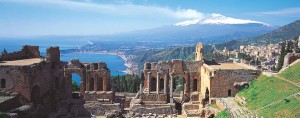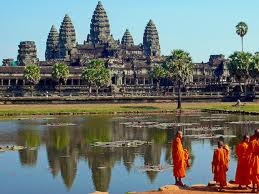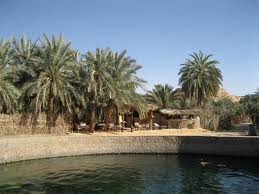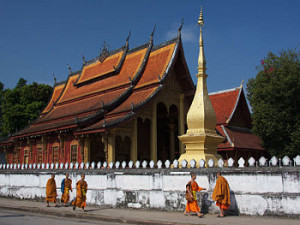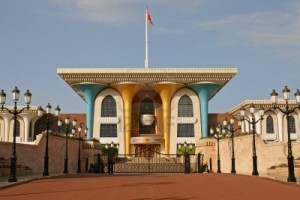These days it’s easy enough to find appealing LGBT travel destinations with comfortable lodgings, good food and pleasant tourist site. Whether by cruise ship, plane or on a bicycle the world is clearly accessible to anyone with a budget and desire to see distant places.
In addition to the popular ports of call such as Palm Springs, Sitges, Paris, Berlin, Florida or Pattaya there are many hidden gems that beckon gay adventure travelers off the beaten trail. Here are six unusual places where LGBT voyagers can sense a ‘gay flavor’ even if there is no gay scene. I have visited each of these places and found a comfort zone in each, even though the larger society may not openly embrace our community.
Taormina in Sicily sits high on a cliff overlooking the Ionian Sea that divides Sicily from the Italian mainland. Even from a distance, far below at sea level, Taormina is spectacular in its high perch which commands a sweeping 180º view across the Mediterranean toward the Greek Isles. A winding road leads up to the ancient town founded in the 7th century BC. Once inside the town the narrow streets and stone buildings immediately engulf a visitor in old world charm with shops, restaurants, markets, old churches, and plazas with grand vistas. There are vestiges of former empires, especially the Greek amphitheater with its stunning background vista across to the snow-capped Mount Etna (that often fumes and occasionally erupts). (photo above)
It is a siren holiday dream that has drawn visitors and artists, actors and writers, royalty and sailors for millennia to its rocky shores and cliffs. Today the invaders are mostly straight European tourists but it wasn’t always so. The man most responsible for the blossoming of gay life in this village was the 19c Baron Wilhelm von Gloeden, an aristocratic German painter and photographer whose eye for beauty ranged from scenic landscapes to wrinkled farmers to innocent-looking pubescent boys (mostly) and girls (some). Von Gloeden’s photos, starting in the 1880’s, of tawny smooth youths tapped int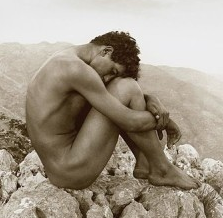 o the sensual fantasies of closeted or socially frustrated denizens from northern Europe longing for relief from the dreary winter months and an outlet for artistic or sexual energies. (photo left)
o the sensual fantasies of closeted or socially frustrated denizens from northern Europe longing for relief from the dreary winter months and an outlet for artistic or sexual energies. (photo left)
One of the earliest aesthetes to respond to von Gloeden’s inspiration was Oscar Wilde who became friends with the photographer and spent more than a few months in Taormina as he worked on his plays, essays, poetry and considerable correspondence with the glitterati of Europe. It is said that Wilde even helped von Gloeden stage some of his photos with props and settings from antiquity, garbing some youths with head garlands or body togas. Following on Wilde’s respite, numerous other artists arrived in the early and mid 20th century in Taormina: Sarah Bernhardt, Oscar Wilde, William Faulkner, André Gide, Somerset Maugham, Jean Cocteau, Marlene Dietrich, Greta Garbo, diplomat and author Roger Peyrefitte, Tennessee Williams and Truman Capote.
Today Taormina is not a particular gay watering hole but there is a small community of LGBT denizens who socialize and dine with friends and family. There is no effort to get organized or hang rainbow flags. Here is a settled laissez-faire attitude as folks go about their business and personal lives. The milieu is clearly and dominantly hetero but it is not repressive and cafes are patronized by a mixed clientele of gay and straight friends and acquaintances.
There one gay-owned and one gay-friendly boutique hotel in Taormina that are comfortable and stylish (of course) and welcome gay visitors year round: The gay-owned place is the modest and affordable Isocos Hotel (Via Salita Branco #2. It’s owned and operated by Michele Scimone whose family has lived in Taormina for four generations. (http://www.isoco.it/inglese/default.asp). The gay-friendly hotel is the more upscale Villa Schuller (http://www.hotelvillaschuler.com/travel/en/gay_friendly_tourism_taormina.htm) with spectacular views of the sea and mountains.
Read more:
(story) http://www.globalgayz.com/gay-sicily-2007-colorful-past-2/265/
(photos) http://www.globalgayz.com/italy-sicily-taormina/524/
Sleepy little Seam Riep town has expanded in recent years due to it proximity to the Angkor Wat temple ruins, one of the most spectacular ancient sites in Asia. As tourists felt safe to return to Cambodia after the horrifying Khmer Rouge years (1975-79), hesitant visitors started arriving in the 1980s and 90s which necessitated new hotels restaurants and businesses. Today Seam Riep is no longer sleepy or little. Hoards of Asian and Euro-American groups and individuals now journey to see the vast and impressive remains of the ancient Khmer empire–which included all of Laos, Cambodia and Thailand.
As usual, among the many travelers to Seam Riep are increasing numbers of LGBT people also seeking historic adventure. There has been a quiet tolerance of ‘differences’ for a long time in the town. “The Cambodian Royal Family, as a whole, share the same point of view as the King-Father,” Sisowath Thomico, a spokesman for the royal family, wrote in an e-mail message to a New York Times writer. “We’ve always been very tolerant about sexual preferences as some Khmer Royals are/were openly gays/lesbians.” As well, the country is historically Buddhist, with an open-minded attitude toward all people. So over the past decade, LGBT entrepreneurs have opened numerous gay hotels, bars and restaurants to suit our community. The result now is a subdued, friendly and visible LGBT scene that co-exists along with the flashier and bigger hetero-focused venues.
But things hardly stay the same for long anywhere. Modern influences from a burgeoning gay scene in Phnom Penh and from neighboring Thailand have inspired locals in Seam Riep to mount their own LGBT festival in recent years. In 2012 the first attempt for a pride event was little more than a gathering of friends, some in drag, with big ideas; but at least it was a start.
The large Asian website Utopia.com offers many more LGBT events and places in the city (http://www.utopia-asia.com/tipscam.htm). Of special note are the gay hotels Mens’s Resort, Virtoth’s Hotel (viroth-hotel.com), Golden Banana Resort, Hotel Be Angkor and Cockatoo Resort. That’s an usually large LGBT offering for a growing town of about 175,000.
Gay owned watering holes are Linga Bar, Miss Wong, Ei8th Bar (http://www.ei8htbar.com/) and Station Wine Bar (http://thestationwinebarsiemreap.com/) with its Thai-look-alike lady boy show every Saturday starting at nine PM. Pyramid Club (http://www.pyramid-megaclub.com/) is mixed but very gay. Also there is Viroth’s Restaurant at their hotel.
Read more: http://www.globalgayz.com/asia/cambodia/
I had vaguely heard of Siwa in the far west of Egypt. But when a friend reported that it was once a place where same-sex couples were able to get married, that it was an extraordinary oasis town in the middle of nowhere, and the location of an ancient temple home of an oracle. I decided to see for myself. I rented a car in Alexandria and drove six hours (with stops) across the parched Western Desert to the remote town with the alluring myths.
As for the weddings there was of course nothing to see. But various sources were sure the tradition was real and actual. However, modern Egypt had brought these to an end when Siwa was made more accessible with a paved road and a stronger legal reach of the moderate Islamist Cairo government.
I also wanted to visit the Temple of Ammon, my namesake temple (also spelled Amun) where Alexander the Great had come in 331 BC to consult with the oracle.
And I was not disappointed by the oasis itself. Much more than a mirage, the place was a forest of tall palms and watering holes. In true desert style I hired a donkey cart and driver to take me around town and out to the nearby salt lake. Contrary to much gay gossip Ali my driver was cheerful and offered no suggestive moves (but this didn’t stop me from wondering how he managed his youthful desires).
Siwa’s Gay History
It difficult to discern fact from fantasy regarding this bit of history. Here are some excerpts from various sources. “Until the Second World War marriages between men were common. During the last century only women, children and men over the age of forty could remain within the city walls which meant that homosexuality was very common amongst the entirely male population outside. The duty of these young men was to work the fields and to guard them from attacks by hostile bedouins. They had a fearsome reputation and were known as “Zaggalah” or “Club bearers”. They also earned a reputation for drunkenness and unashamed homoerotic relationships. As late as 1938 one horrified British army officer spoke with evident distaste of the oasis’ “degenerate inhabitants.”
“During the Second World War the oasis, which was close to Egypt’s border with Axis controlled Libya, served as a base for British special operations against Rommel’s Panzer Army Africa. It may have been this inflow of outsiders which led to negative reports being sent back to Cairo which in turn seems to have resulted in the outlawing of gay marriages in the oasis soon after the war’s end. However such relationships, though now illicit, are rumored to still continue to flourish today–discreetly…”
http://boards.straightdope.com/sdmb/showthread.php?t=242291
Alexander’s Visit
In 331BC Alexander the Great made a special trip across the desert to find Siwa in search of a famous oracle who lived in the temple to the god Amun (Ammon). He wanted to know if he was of divine origin (son of the god Ammon-Ra or Amun-Ra). After the consult he never revealed what was said but it must have been inspiring because Alexander went off to conquer most of the known world all the way to India. “For whatever reason Alexander was so happy here he declared he would be buried in Siwa. Today some historians are hopeful they can find his tomb. But despite much searching the tomb of Alexander remains to be discovered.”
(http://www.davecullen.com/forum/index.php?topic=26820.430;wap2)
One fanciful write has embellished the story with this: “the oracle promised him great conquests and he probably also enjoyed the company of some of the handsome Siwan men. Alexander’s bisexuality is well-known and some of the young priests may have earned a living as male prostitutes.”
On my visit the ruins of the Temple of Ammon still existed and are being preserved by German archeologists.
Read more: http://www.globalgayz.com/africa/egypt/
(photos) http://www.globalgayz.com/siwa-oasis-village/460/
In a country where homosexuality is illegal, politically condemned and socially scorned there is no room for any show of sexual variety. Heterosexuality is the norm and marriage is the standard condition that produces 6 to 10 children. That’s the official line.
But a different story emerges from a bit of research online. Go to CambodiaOut.com, Utopia-Asia.com or PurpleDragon.com and what appears is a modest list of places to sleep, eat and drink, owned or managed by ‘gay-friendly’ personnel. As in Vientiane, a foreign partner/boyfriend (farang) supplies the investment cash and the Lao supplies local knowhow and the legal right to own the property; the farang can own the business but not the land… So goes ‘gay life’ in Laos and it can be a bumpy ride.
Regarding any gay community in Luang Prabang, there is none. There is no specific gay venue; every gathering place in the city (food and drink) is gay-friendly. The scene is totally mixed although there are some preferred venues where LGBTs are known to gather in the evening after work.
Even ‘gather’ is too strong a word; perhaps mingle is better. And if a place is favored, the owner is not thrilled since the city is not large the police know everything that goes on. Owners, especially a gay farang with a gay Lao partner must show discretion and appear to uphold social standards. A mixed crowd is clearly better than an all male one, said one owner.
In a recent visit to the historic and picturesque city of Luang Probang, GlobalGayz found a quiet LGBT community embedded in the personal and commercial fabric of the city. But the bonding and commitment among LGBT folks was not as strong as elsewhere. One opinion was that family loyalty was more important than any commitment to another man in Lao tradition. As swell, giving priority to sexual and emotional male-based intimacy is not something within the Lao male scope of normality. It is not a common experience for young Lao men who are gay. Add the fact that often one of the partners was a ‘faring’ foreigner did not give the relationship a solid base.
So there a gay community but it seemed held together with tenuous commitments and business deals mixed in with sexual and romantic attraction. It’s not an unusual mix in Asia where money, power, age, cultural traditions and secret/unconscious agendas flow together in a jumble of effort and desire that draws two people together toward fragile and unpredictable results–sometimes happy, sometimes not.
Read more: http://www.globalgayz.com/gay-life-in-laos-luang-prabang-2010/376/
(photos) http://globalgayz.wpengine.com/luang-prabang/
Homosexuality is illegal in Oman and is an offense that can bring a jail sentence of up to three years. However it is rarely invoked unless there is a strong social violation involved. Without being said aloud, homosexuality is quietly acknowledged in the Omani culture, unlike some Middle East countries that try to deny its existence or impose severe sentences.
Despite being a conservative and religious country Oman does not demonize gay people as a western threat to the order of life. There is a calm tolerance (ignorance? indifference?) of LGBT life as long as it is not seen to offend public sensibility with displays of affection. But discerning such affection is ambiguous and unclear since public fondness is part of the public ethos: men and women greet friends with hugs and kisses to both cheeks and often hold hands.
One online commentary offers some insight: “On the other hand, the second group (men who like to have sex with men but don’t identify as being homosexual) are present, and there does seem to be a certain amount of unspoken consent within traditional society about male-male sex, given the very limited mixing of the genders. In recent years, we’ve met some Omanis who identify as gay. Like many in the Arab world, most are very closeted and many if not most are married and living, sometimes very happily, what would seem to a Westerner like a double life: wife, kids, and family on one hand, and a social/sexual life with other men on the other.”
Cultural attitudes are also reflected silently in the ease with which LGBT Omani live their lives. They do not live in fear of witch-hunts or death squads or wandering vigilante purists who, as in Iraq, have been known to torture and kill gays or suspected gays on the spot. Such attitudes could be said to emanate from the more progressive and open-minded Sultan himself: women are more respected here and can even run for elected office; Israel is not seen as a hostile enemy; a classical youth symphony orchestra is sponsored by the Sultan; and he does not delve into the private lives of his subjects.
Another visitor wrote this: “The Sultinate of Oman, which has beautiful beaches and historic buildings. The Sultan is said to be open-minded so attitudes are more liberal than elsewhere in the Arab world. It’s well known that in the Islamic world younger unmarried guys are willing to have sex with other men because it is their only sexual outlet. That said,they also have to be very cautious since any sexual scandal would bring dishonor to their families. So it’s all very hush-hush.”
Read more: http://www.globalgayz.com/gay-life-in-oman/1841/
Also: http://muscatconfidential.blogspot.com/2010/02/exclusive-interview-being-gay-in.html
6—-Antigua, Guatemala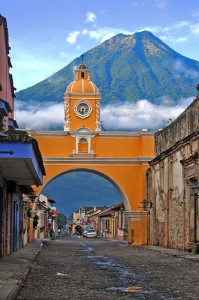
This charming town appears like an outdoor museum with its cobblestone streets lined with classic Spanish style facades and tiled courtyards. In the center is a picturesque green park with a central fountain where locals and visitors gather day and night to talk, sing, sell local souvenirs, and people-watch.
Many natives and foreigners come and go each year and some fall in love with the place and stay. Among the folks who stay are a small LGBT community of friends and acquaintances who all know each other but are not organized into an association, mostly business people and some retirees. (Nearby Guatemala City has more gay venues as well as an LGBT activist organization called Oasis.)
There is virtually no LGBT discrimination here in hotels, markets, restaurants or public venues. The place could be called ‘gay light’ since there is no active ‘scene’. Instead, woven into the fabric of Antigua life are several LGBT gay-owned restaurants/bars/cafes where there are occasional LGBT nights, one in (lesbian owned) Frida’s bar/restaurant (last Saturday of each month) and certain nights at Ricky’s bar a block away. Casbah disco is known as gay friendly all the time. There are two gay-owned restaurants, daVinci and Gringo-Chapin, both in central area.
That’s pretty much it it for the LGBT scene, unless casual strolling at sunset in Central Park is included. During a recent visit to this charming place, GlobalGayz interviewed some of these folks who are happily living and working in Antigua.
Jack and Bismarck (American and Nicaraguan) own a small eatery called Gringo-Chapin; Gonzalo is a Mayan Guatemalan who has lived here all his life and dresses in native brightly colored clothes and a straw bowler hat; Dahr and George (Ladino and American) are not a couple but are business associates in a tourism business called George’s Travel Club; Luis and Walter own the elegant and ornamented daVinci Restaurant where a continental menu is served.
Read more: http://www.globalgayz.com/gay-antigua-guatemala-2012/1991/
(photos): http://www.globalgayz.com/guatemala-antigua-photo-gallery-2012/1959/
By Richard Ammon
GlobalGayz.com
May 2013

